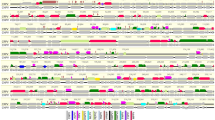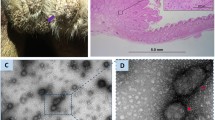Abstract
Avipoxvirus (APV) infections have been observed in a wide variety of wild, captive and domestic avian hosts, recently including a range of island endemic and endangered species. However, not enough is known about genome diversity and phylogenetic relationships of APVs, as well as their host-range specificity. A wild stone curlew (Burhinus oedicnemus) was recovered in Sardinia (Italy), showing large wart-like lesions and nodules on both legs and toes, which resulted positive to poxvirus by PCR. Histopathological examination of the lesions showed ballooning degeneration and large intracytoplasmic inclusion bodies consistent with APV infection. A multiple gene sequencing approach was applied to highlight the phylogenetic relationships of this virus with a panel of selected APVs at the clade and subclade levels. This novel isolate was characterized by sequencing partial 4b core protein, P35 (locus fpv140) and DNA polymerase genes and phylogenetic analyses assigned it to clade A, (Fowlpox virus, FWPV), subclade A2. Conservation implications of avian pox presence in Sardinian stone curlews and possibly in other island bird species are discussed.




Similar content being viewed by others
References
Abdallah FM, Hassanin O (2013) Detection and molecular characterization of avipoxviruses isolated from different avian species in Egypt. Virus Genes 46:63–70
Bányai K, Palya V, Dénes B, Glávits R, Ivanics É, Horváth B, Farkas SL, Marton S, Bálint Á, Gyuranecz M, Erdélyi K, Dán Á (2015) Unique genomic organization of a novel avipoxvirus detected in Turkey (Meleagris gallopavo). Infect Genet Evol 35:221–229
Bolte AL, Meurer J, Kaleta F (1999) Avian host spectrum of avipoxviruses. Avian Pathol 28:415–432
Calabuig P, Casal AB, Camacho M, Oròs J (2011) Poxvirus infection in stone curlews in the Canary Islands. Vet Rec 168(6):168
Deem SL, Cruz MB, Higashiguchi JM, Parker PG (2011) Diseases of poultry and endemic birds in Galapagos: implications for the reintroduction of native species. Anim Conserv 15:73–82
Giunchi D, Caccamo C, Mori A, Fox JW, Godoy FR, Baldaccini NE (2015) Pattern of non-breeding movements by stone-curlews Burhinus oedicnemus breeding in northern Italy. J Ornithol 156(4):991–998
Godoy LA, Dalbeck LS, Tell LA, Woods LW, Colwell R, Robinson B, Wethington SM, Moresco A, Woolcock PR, Ernest HB (2013) Characterization of avian poxvirus in Anna's hummingbird (Calypte anna) in California, USA. J Wildl Dis 49(4):978–985
Gyuranecz M, Foster JT, Dan A, Ip HS, Egstad KF, Parker PG, Higashiguchi JM, Skinner MA, Hofle U, Kreizinger Z, Dorrestein GM, Solt S, Sos E, Kim YJ, Uhart M, Pereda A, Gonzalez-Hein G, Hidalgo H, Blanco JM, Erdelyi K (2013) Worldwide phylogenetic relationship of avian poxviruses. J Virol 87:4938–4951
Hall TA (1999) BioEdit: a user-friendly biological sequence alignment editor and analysis program for windows 95/98NT. Nucleic Acids Symp Ser 41:95–98
Jarmin S, Manvell R, Gough RE, Laidlaw SM, Skinner MA (2006) Avipoxvirus phylogenetics: identification of a PCR length polymorphism that discriminates between the two major clades. J Gen Virol 87:2191–2201
Kane OJ, Uhart MM, Rago V, Pereda AJ, Smith JR, Van Buren A, Clark JA, Boersma PD (2012) Avian pox in Magellanic penguins (Spheniscus magellanicus). J Wildl Dis 78(3):790–794
King MJ, Adams EB, Carstens EJ (2012) In: Lefkowitz (ed) Virus taxonomy: ninth report of the international committee on taxonomy of viruses. Elsevier Academic Press, London
Kleindorfer S, Dudaniec RY (2006) Increasing prevalence of avian poxvirus in Darwin's finches and its effect on male pairing success. J Avian Bio 37:69–76
Krone O, Essbauer S, Wibbelt G, Isa G, Rudolph M, Gough RE (2004) Avipoxvirus infection in peregrine falcons (Falco peregrinus) from a reintroduction programme in Germany. Vet Rec 154:110–113
Lachish S, Lawson B, Cunningham AA, Sheldon BC (2012) Epidemiology of the emergent disease Paridae Pox in an intensively studied wild bird population. PLoS One 7(11)
Lee LH, Lee KH (1997) Application of the polymerase chain reaction for the diagnosis of fowl poxvirus infection. J Virol Methods 63:113–119
Le Loc’h G, Ducatez MF, Camus-Bouclainville C, Guerin JL, Bertagnoli S (2014) Diversity of avipoxviruses in captive-bred Houbara bustard. Vet Res 45:98
Lierz M, Bergmann V, Isa G, Czerny CP, Lueschow D, Mwanzia J, Prusas C, Hafez HH (2007) Avipoxvirus infection in a collection of captive stone curlews (Burhinus oedicnemus). J Avian Medic Surg 21:50–55
Luschow D, Hoffmann T, Hafez H (2004) Differentiation of avian poxvirus strains on the basis of nucleotide sequences of 4b gene fragment. Avian Dis 48:453–462
Perez-Tris J, Williams RAJ, Abel-Fernandez E, Barreiro J, Conesa JJ, Figuerola J, Martinez-Martinez M, Ramirez A, Benitez L (2011) A multiplex PCR for detection of poxvirus and papillomavirus in cutaneous warts from live birds and museum skins. Avian Dis 55:545–553
Rampin T, Pisoni G, Manarolla G, Gallazzi D, Sironi G (2007) Epornitic of avian pox in common buzzards (Buteo buteo): virus isolation and molecular biological characterization. Avian Pathol 36:161–165
Smits JE, Tella JL, Carrete M, Serrano D, Lopez G (2005) An epizootic of avian pox in endemic short-toed larks (Calandrella rufescens) and Berthelot's pipits (Anthus bertheloth) in the Canary Islands. Spain Vet Pathol 42:59–65
Tamura K, Peterson D, Peterson N, Stecher G, Nei M, Kumar S (2011) MEGA5: molecular evolutionary genetics analysis using maximum likelihood, evolutionary distance, and maximum parsimony methods. Mol Biol Evol 28:2731–2739
Thiel T, Whiteman NK, Tirape A, Baquero MI, Cedeno V, Walsh T, Uzcategui GJ, Parker PG (2005) Characterization of canarypox-like viruses infecting endemic birds in the Galapagos Islands. J Wildl Dis 41:342–353
VanDevanter DR, Warrener P, Bennett L, Schultz ER, Coulter S, Garber RL, Rose TM (1996) Detection and analysis of diverse herpesviral species by consensus primer PCR. J Clin Microbiol 34(7):1666–1671
Author information
Authors and Affiliations
Corresponding author
Ethics declarations
Conflict of interest
The authors declare that they have no conflict of interest.
Rights and permissions
About this article
Cite this article
Lecis, R., Secci, F., Antuofermo, E. et al. Multiple gene typing and phylogeny of avipoxvirus associated with cutaneous lesions in a stone curlew. Vet Res Commun 41, 77–83 (2017). https://doi.org/10.1007/s11259-016-9674-5
Received:
Accepted:
Published:
Issue Date:
DOI: https://doi.org/10.1007/s11259-016-9674-5




